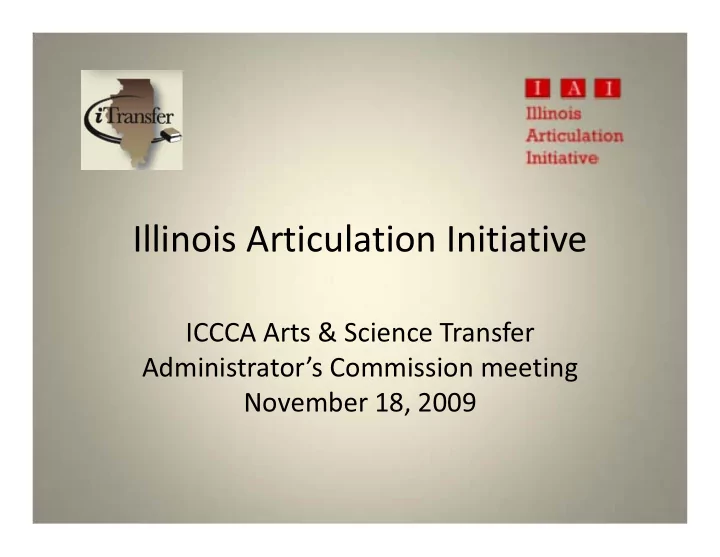

����������������������������������� Illinois Articulation Initiative ICCCA Arts & Science Transfer November 18, 2009
� ������������������������������������������������ ����������� IAI Origins � Jointly launched in 1993 by the IBHE, ICCB, and the Transfer Coordinators from Illinois Colleges and Universities � Purpose: To facilitate transfer in Illinois the Committee on the Study of Undergraduate
IAI Origins � Key Components of the IAI: � Associate and baccalaureate degree-granting institutions are equal partners in providing the first two years of baccalaureate programs � Faculty must take primary responsibility for developing and maintaining program and course articulation � Institutions are expected to work together to assure that lower-division baccalaureate programs are comparable in scope, quality, and academic rigor
IAI Development � Phase I: develop a general education package, the General Education Core Curriculum (GECC) � The General Education Core Curriculum (GECC) was adopted by the IAI Steering Panel, then endorsed by IBHE, ICCB, and ISBE � Effective for Freshmen entering in summer 1998
IAI Development � Phase II: create models for easing transfer into baccalaureate major programs � Evolving following 2006 evaluation and ongoing need analysis
������������������������������ IAI Development � Phase III: institute a process of regular five- year reviews designed to evaluate the efficacy � Ongoing
IAI Development � Phase IV: comprehensive evaluation of the IAI processes, procedures, and goals � Adopted by IBHE and ICCB 2006 � Current policies and procedures reflect revisions based on this evaluation
IAI Development � Ongoing evaluation of IAI strengths and weaknesses
Organization Chart & Roles
������������������������������������������� General Education Core Curriculum (GECC) � The GECC is transferred as a package replacing requirements � Individual courses may be accepted in transfer at the discretion of the receiving institution.
General Education Core Curriculum � A total of 37-41 semester credit hours � Communication (9 sem. hours) � Mathematics (3 to 6 sem. hours) � Physical and Life Sciences (7 to 8 sem. hours with at least one lab) � Humanities and Fine Arts (9 sem. hours) � Social and Behavioral Sciences (9 sem. hours) � Quarter hour conversion: � 12 to 14 courses of 56 to 61 quarter credits � three quarter credits equal two semester credits
GECC Completion Post-matriculation � Participating institutions will offer transfer students the option of satisfying lower-division general education requirements by completing a GECC curriculum while enrolled in the receiving institution when: � the transfer student has completed a statewide articulated associate degree such as the AFA, AES, AAT; or � the transfer student has been granted 30 semester hours of transfer credit by the receiving institution without having completed the GECC.
� � � � GECC Panel Roles and Responsibilities Provide a forum for faculty from participating institutions to guide the GECC, and to develop common understandings about general education objectives and curriculum content. Develop the general content guidelines and learning objectives for courses to be included within the GECC package. Articulate the rationale for the content guidelines and learning objectives for courses to meet the GECC requirements. Conduct the final review of courses to determine if they meet the IAI guidelines and learning objectives for inclusion in the GECC.
Major Panel Roles and Responsibilities � Identify a Common Core for the Major/Discipline of no more than four (4) courses. � Review submissions by participating institutions for approval � Approved courses will be listed in the IAI database. � Provide a forum for faculty and administrators to develop common understandings about the lower- division objectives and curriculum content in the discipline. � Develop course, content, or learning objective recommendations for students who have chosen a major but have not decided upon a baccalaureate institution.
Panel Membership � A fully-complemented panel will include: � Nine community college faculty � One community college academic officer � Eight public university faculty � Four independent institution faculty � Three transfer coordinators, one from each sector � Individual membership on a panel will be for a term of 3 years.
IAI Use � As of September 2009: � over 9,631 courses have been in the GECC database in the � 6,714 are currently active GECC courses � Over 110 Institutions participate; 95 are full participants � Over 700 faculty participate in the panels
������������������������������������� ��������������������������������� Developing Statewide Transfer Policy � Goal Three of the Illinois Public Agenda for College and Career Success � ���������� the number of high-quality postsecondary credentials to meet the demands of the economy and � ���������������������������� articulation through stable funding and expansion of transfer tools such as u.select and the Illinois Articulation Initiative and through development of an objective measure of
Developing Statewide Transfer Policy � Tools for facilitating transfer � Effective advising � Articulation agreements between institutions � Community College Compact Agreement � IAI GECC � IAI Major panel recommendations � u.select � www.itransfer.org
Developing Statewide Transfer Policy � Consider along with other state level policies � For example, � American Diploma Project / Common Core State Standards Initiative � Dual Credit Quality Act
Developing Statewide Transfer Policy � Types of Transfer Students � Those who know their intended transfer institution and their major. � Those who have an intended transfer institution but are undecided about a major. � Those who know their major, but are undecided about their intended transfer institution. � Those who know neither their intended transfer institution nor their major.
Future Directions � Ongoing evaluation of IAI strengths and weaknesses � Five Year Review Process � Strengthen pathways for those who know their major but are undecided about their transfer institution � Continue dissemination of information � Coordination with other policy efforts
Recommend
More recommend